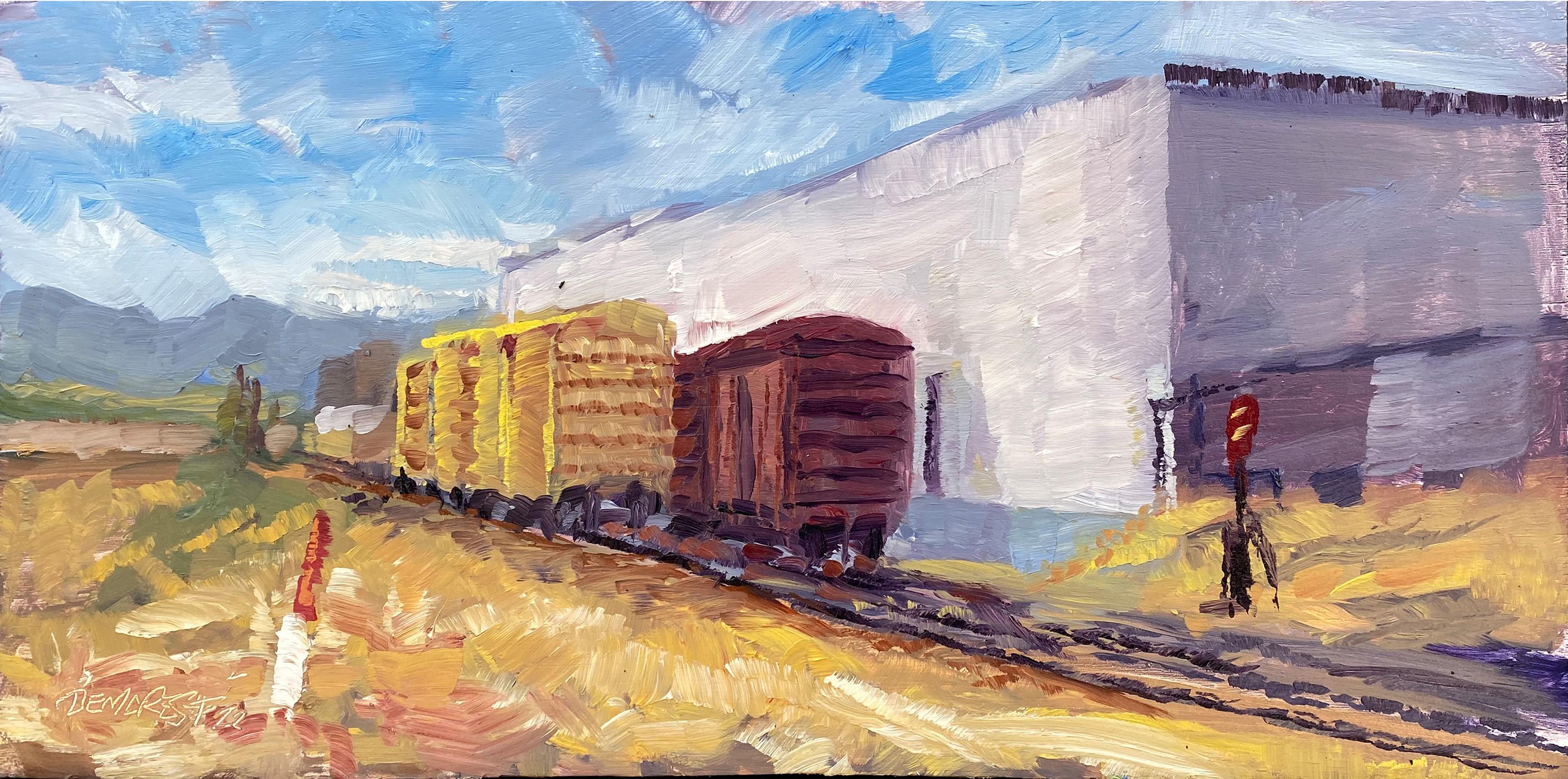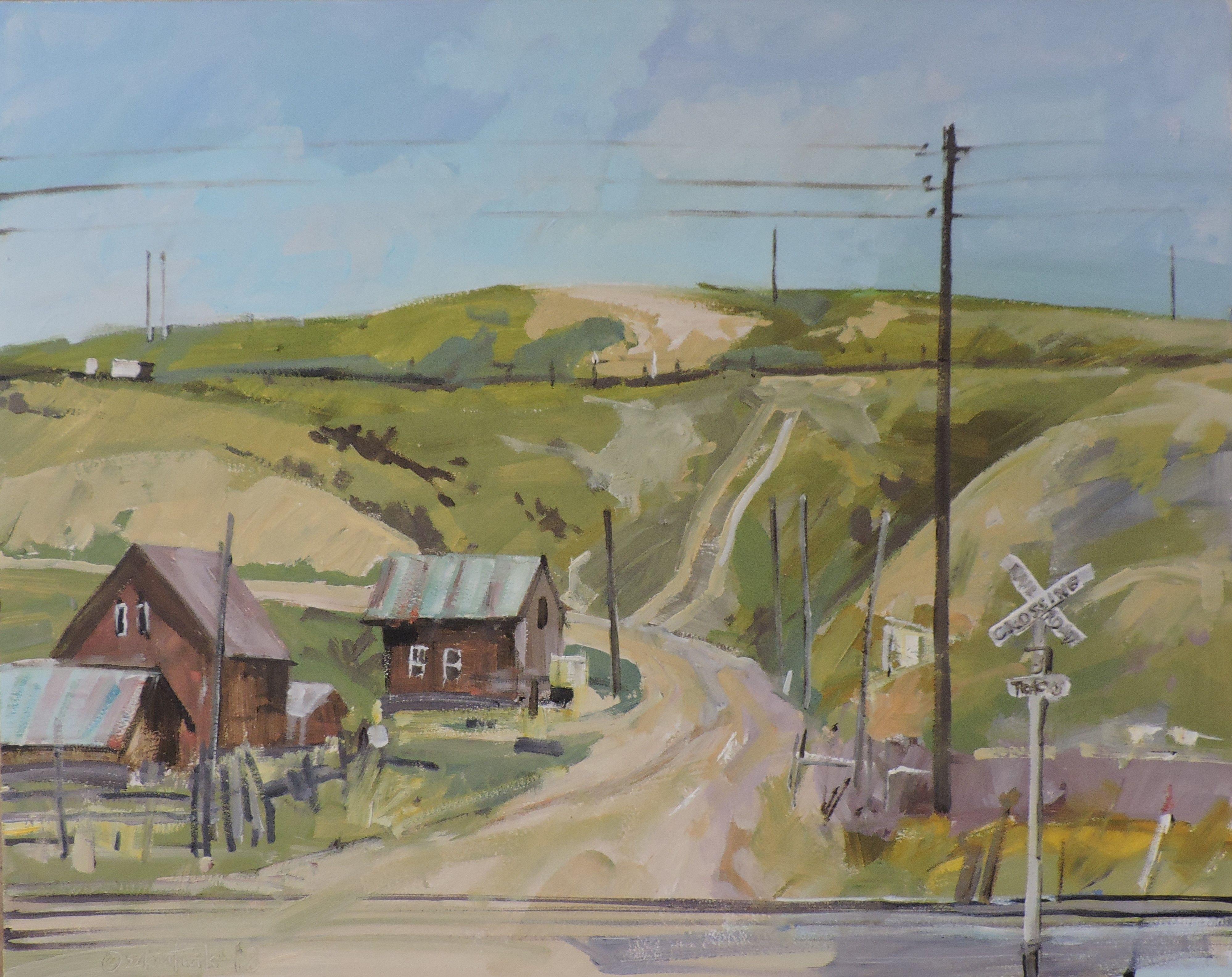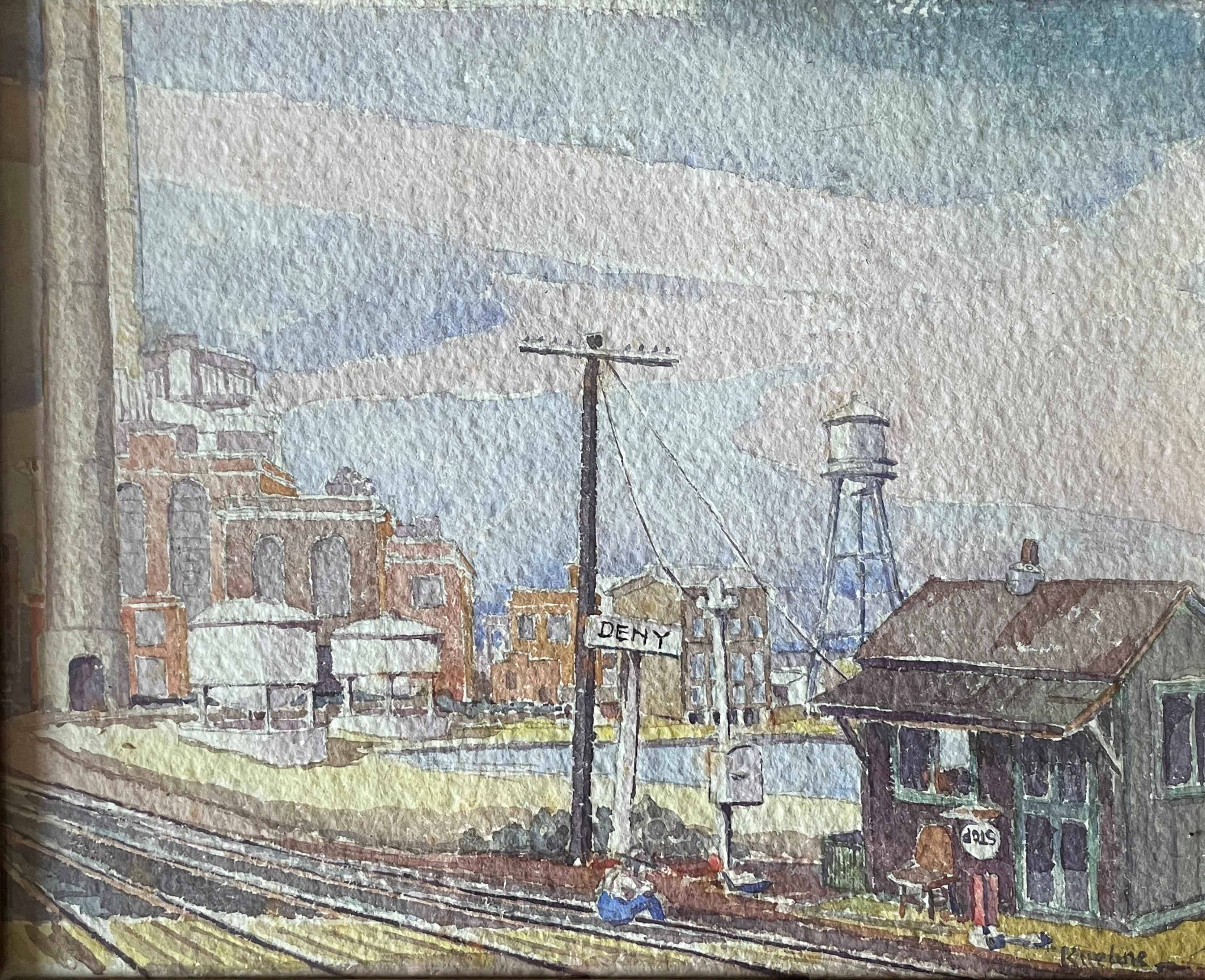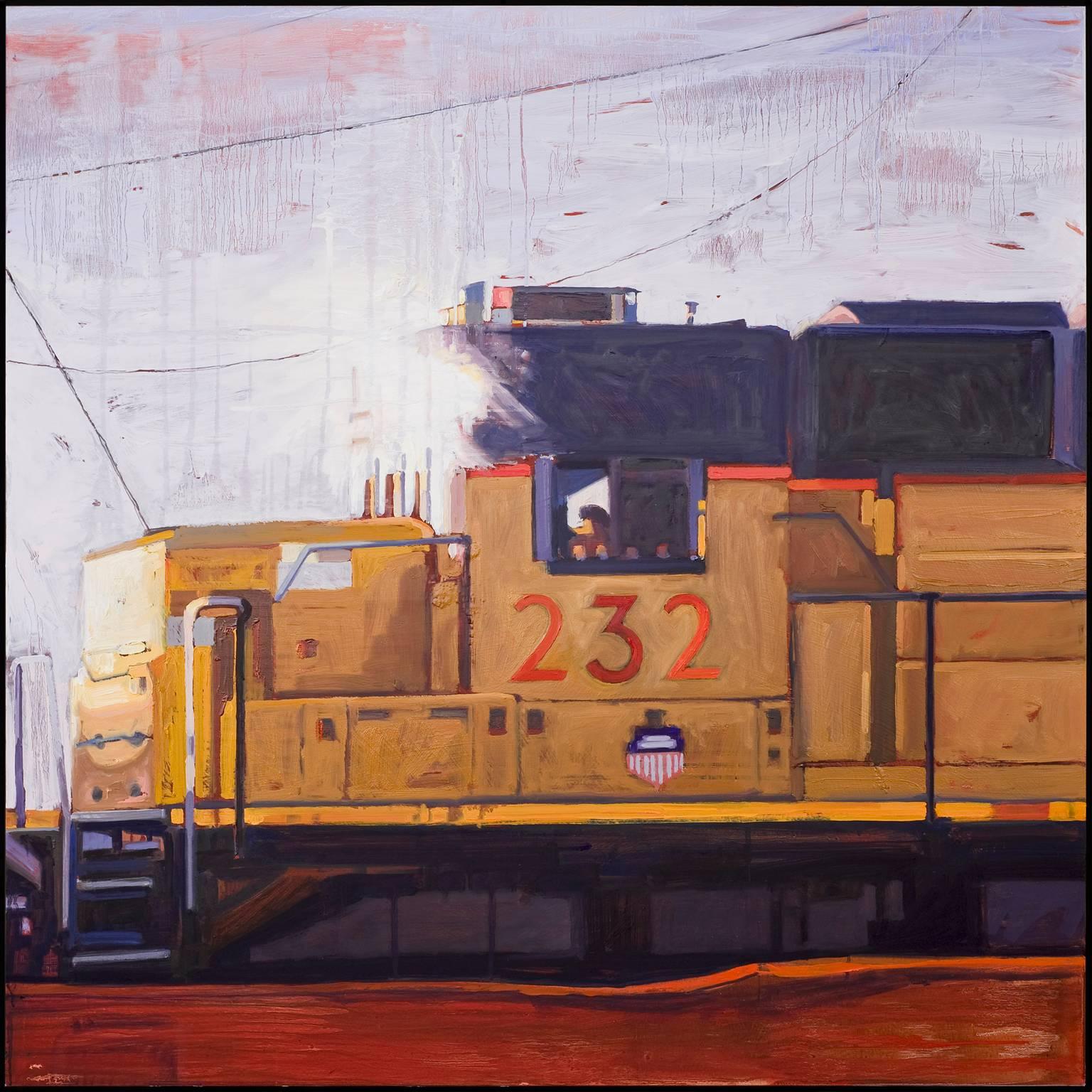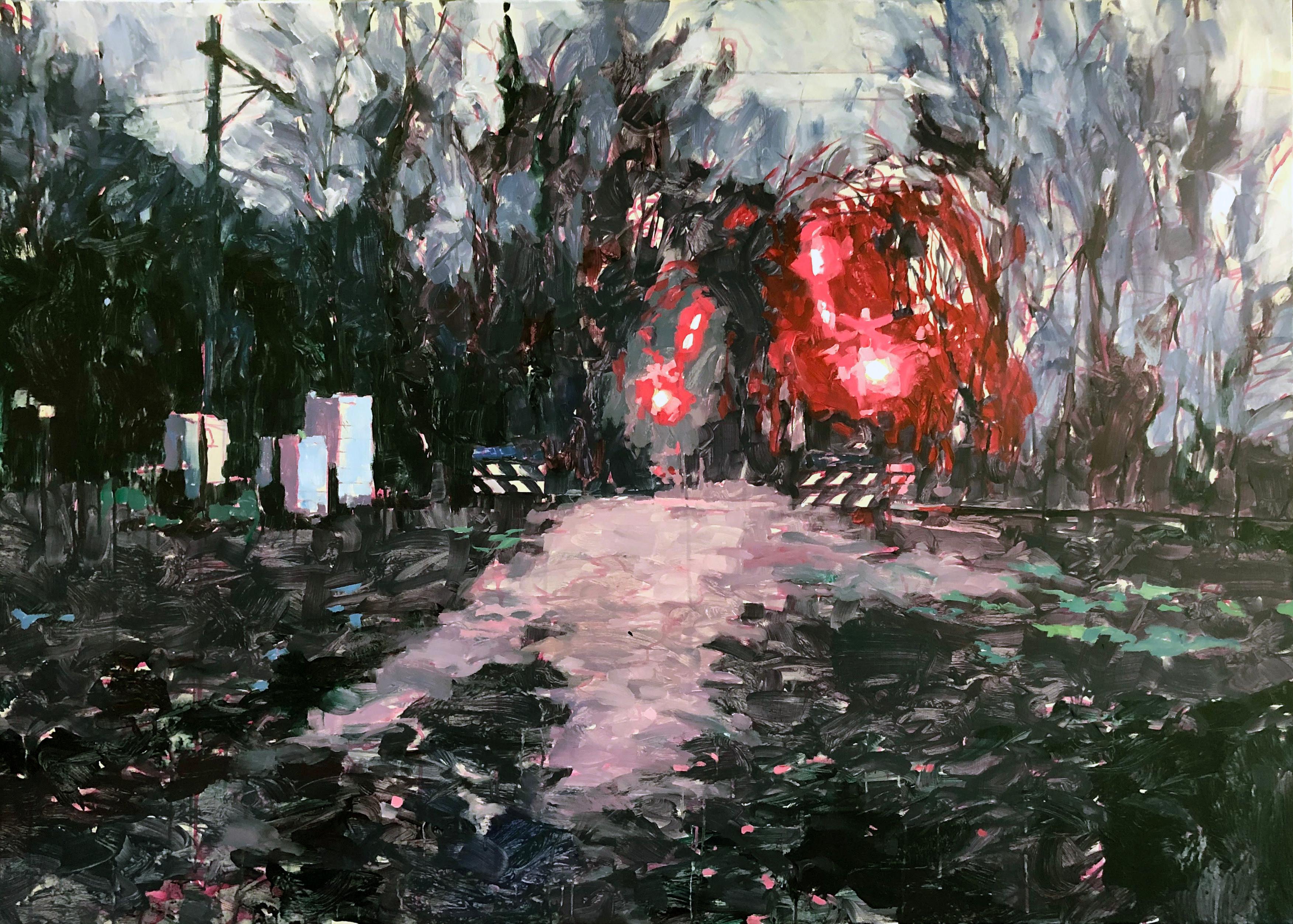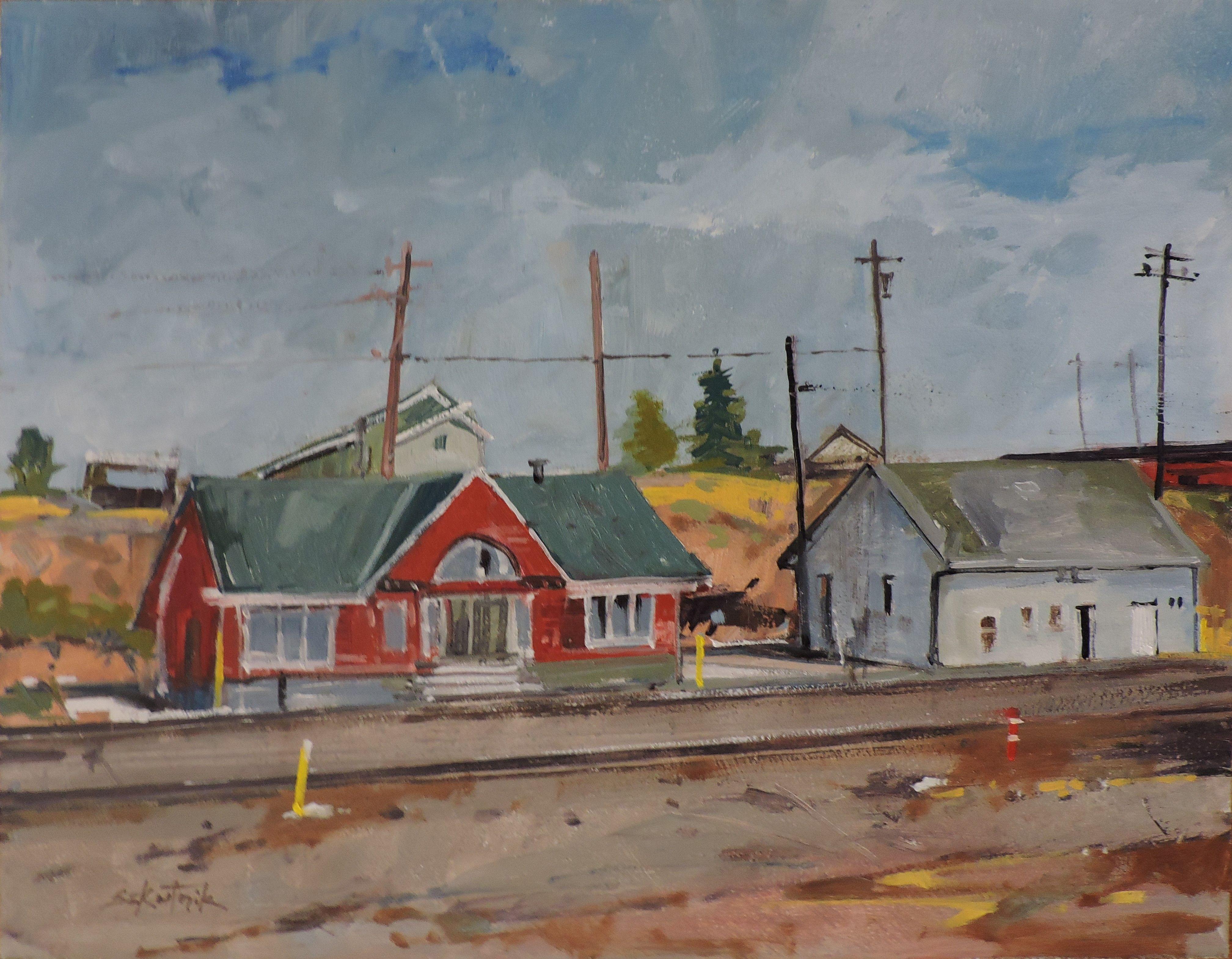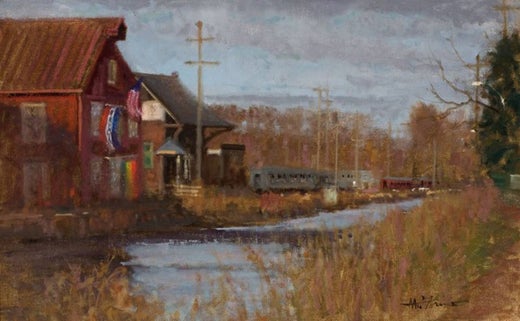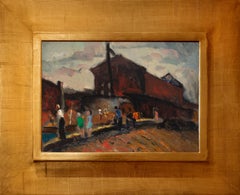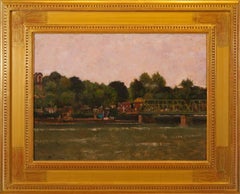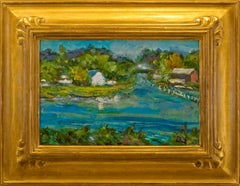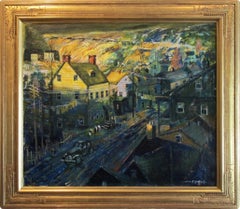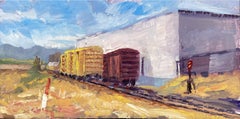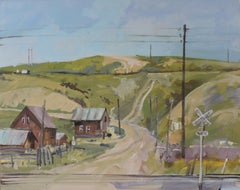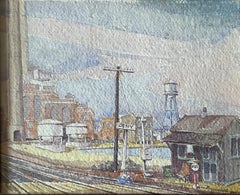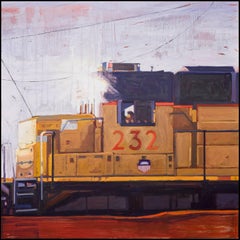Items Similar to "Early Light, New Hope Railway Yard"
Want more images or videos?
Request additional images or videos from the seller
1 of 5
Anthony Michael Autorino"Early Light, New Hope Railway Yard"2006
2006
$12,300
£9,275.42
€10,727.47
CA$17,256.83
A$19,182.04
CHF 10,054.82
MX$234,259.16
NOK 125,528.58
SEK 118,098.97
DKK 80,066.72
About the Item
Jim’s of Lambertville is proud to offer this artwork by:
Anthony Michael Autorino (1937 – 2015)
The son of Italian immigrants, Anthony Michael Autorino was born on September 29, 1937 in Montclair, New Jersey. As a teenager, Autorino enlisted in the United States Air Force where he served an eight-year tour. His expertise in the field of cryptography landed him in Paris in the mid-1950s as an Air Force sergeant working at the United States Embassy.
While in Paris, Anthony became quite involved in the art community which reinforced his desire to make painting his career focus. Upon returning to the United States in 1961, Autorino divided time painting between upstate New York and New England. By the mid-1960s, New York City had become the center of activity for the career of this highly regarded young artist.
By 1968, disillusioned by the hustle and bustle, Autorino made the decision to relocate. His passion for paintings nature and the outdoors led him to the Delaware Valley. Charmed by the welcoming art community, New Hope would be the home of the new studio/gallery named “The Gallery” on Mechanic Street. In 1982, “The Gallery” was relocated across the river to neighboring Lambertville, New Jersey, where it remained for twenty years.
In the 1980s, he took up residence and studio in Buckingham, Pennsylvania, at the former home of renowned New Hope Impressionist, George Sotter.
Largely self-taught, Anthony exhibited at the National Academy of Design in New York City, the Salmagundi Club, the Allied Artists, the American Watercolor Society and the Philadelphia Sketch Club. He has received many awards and honors for his paintings, which are represented in numerous private, institutional and corporate collections internationally.
His preferred medium is oil and he draws inspiration from his local predecessors, such as Edward Redfield, Daniel Garber, William Lathrop, George Sotter and Robert Spencer as well as “Hudson River School” great, George Inness.
Autorino’s work is unique in style and combines an early twentieth century feel with present-day subjects. His soft palette masterfully captures the mood of each individual setting from falling snow to nocturnal views of the Delaware River. Anthony’s work is clearly a continuing chapter in the story of “New Hope School” Impressionist painting.
Source: New Hope for American Art, James Alterman
- Creator:Anthony Michael Autorino (1937, American)
- Creation Year:2006
- Dimensions:Height: 23 in (58.42 cm)Width: 32 in (81.28 cm)Depth: 2 in (5.08 cm)
- Medium:
- Movement & Style:
- Period:
- Condition:
- Gallery Location:Lambertville, NJ
- Reference Number:1stDibs: LU374553342
Anthony Michael Autorino
Anthony Michael Autorino was born in 1937 in Montclair, New Jersey. He served in the United States Air Force by working at the American Embassy in Paris in the mid-1950s. In Paris Autorino became involved in the art community and, upon returning to the United States in 1961, began painting. In 1968, Autorino moved to New Hope, Pennsylvania, where he set up a studio and gallery space, eventually relocating his gallery to Lambertville, New Jersey. In 1982 he moved into the former home of renowned New Hope Impressionist, Goerge Sotter, where he set up his studio. Autorino exhibited at the National Academy of Design, the Salmagundi Club, the Allied Artists, the American Watercolor Society and the Philadelphia Sketch Club. He received many awards and honors for his paintings. His work is in numerous private, institutional and corporate collections.
About the Seller
5.0
Vetted Professional Seller
Every seller passes strict standards for authenticity and reliability
Established in 1997
1stDibs seller since 2014
38 sales on 1stDibs
Typical response time: 22 hours
- ShippingRetrieving quote...Shipping from: Lambertville, NJ
- Return Policy
Authenticity Guarantee
In the unlikely event there’s an issue with an item’s authenticity, contact us within 1 year for a full refund. DetailsMoney-Back Guarantee
If your item is not as described, is damaged in transit, or does not arrive, contact us within 7 days for a full refund. Details24-Hour Cancellation
You have a 24-hour grace period in which to reconsider your purchase, with no questions asked.Vetted Professional Sellers
Our world-class sellers must adhere to strict standards for service and quality, maintaining the integrity of our listings.Price-Match Guarantee
If you find that a seller listed the same item for a lower price elsewhere, we’ll match it.Trusted Global Delivery
Our best-in-class carrier network provides specialized shipping options worldwide, including custom delivery.More From This Seller
View All"The Train Depot"
By Gershon Benjamin
Located in Lambertville, NJ
Jim’s of Lambertville is proud to offer this artwork by:
Gershon Benjamin (1899-1985)
An American Modernist of portraits, landscapes, still lives, and the urban scene, Gershon Benj...
Category
1930s Modern Landscape Paintings
Materials
Oil, Board
"High Water, New Hope"
By Anthony Michael Autorino
Located in Lambertville, NJ
Jim’s of Lambertville is proud to offer this artwork.
Signed lower left.
Anthony Michael Autorino (1937 - 2015)
The son of Italian immigrants, Anthony Michael Autorino was born on September 29, 1937 in Montclair, New Jersey. As a teenager, Autorino enlisted in the United States Air Force where he served an eight-year tour. His expertise in the field of cryptography landed him in Paris in the mid-1950s as an Air Force sergeant working at the United States Embassy.
While in Paris, Anthony became quite involved in the art community which reinforced his desire to make painting his career focus. Upon returning to the United States in 1961, Autorino divided time painting between upstate New York and New England. By the mid-1960s, New York City had become the center of activity for the career of this highly regarded young artist.
By 1968, disillusioned by the hustle and bustle, Autorino made the decision to relocate. His passion for paintings nature and the outdoors led him to the Delaware Valley. Charmed by the welcoming art...
Category
21st Century and Contemporary American Impressionist Landscape Paintings
Materials
Oil
"Canal House, Lumberville"
By Evelyn Faherty
Located in Lambertville, NJ
Jim’s of Lambertville is proud to offer this artwork.
Signed lower right.
Evelyn Faherty (1919-2015)
Evelyn Faherty was born in the early 20th century and made her home in Yardley, Pennsylvania. She is a Bucks County Impressionist...
Category
20th Century American Impressionist Landscape Paintings
Materials
Oil, Board
“Evening in Newark”
By John R. Grabach
Located in Lambertville, NJ
Illustrated in "New Hope for American Art", pg. 194.
Jim’s of Lambertville is proud to offer this artwork by:
John R. Grabach (1886 - 1981)
John Grabach was a highly regarded New ...
Category
20th Century American Impressionist Landscape Paintings
Materials
Canvas, Oil
"Sunrise, Old Farm, Rushland"
By Joseph Barrett
Located in Lambertville, NJ
Illustrated in "Joseph Barrett, The Prime Years 1970s - 1990s", pg. 58, plate #067.
Jim’s of Lambertville is proud to offer this artwork by:
Joseph Barrett (1936 – )
Joseph Barrett was born in Midland, North Carolina, in 1936 and studied at the Massachusetts College of Art in Boston and at the Tyler School of Art in Philadelphia. Barrett, now of Lahaska, Pennsylvania, has been painting his entire adult life. His favorite subjects include the landscape surrounding New Hope and many local landmarks often encompassing figures into his compositions. Barrett utilizes a heavy impasto and his palette bears similarities to that of Fern Coppedge and George Sotter. Barrett’s paintings are always found in unique and somewhat charming handmade frames designed by the artist and finished in metal leaf.
A living contemporary of the no longer living “New Hope School” impressionist painters, Joseph Barrett resides outside of New Hope above his old-fashioned antique shop and studio. Entering Barrett’s shop is like taking a step back in time. Inside this cluttered and dusty haven of treasures from the past, is a studio spanning only four by eight feet. This little studio, containing cans of old brushes...
Category
Late 20th Century American Impressionist Landscape Paintings
Materials
Canvas, Oil
"Canal Bend"
By Evelyn Faherty
Located in Lambertville, NJ
Jim’s of Lambertville is proud to offer this artwork.
Signed lower right.
Evelyn Faherty (1919-2015)
Evelyn Faherty was born in the early 20th century and made her home in Yardley, Pennsylvania. She is a Bucks County Impressionist...
Category
20th Century American Impressionist Landscape Paintings
Materials
Oil, Board
You May Also Like
"Trackside 2" (2023) by Delton Demarest, Original Oil Painting
Located in Denver, CO
Delton Demarest's "Trackside 2" (2022) is an original oil painting depicting a train passing by.
Delton Demarest has been working in the freelance industry for many years. Recent an...
Category
21st Century and Contemporary Impressionist Figurative Paintings
Materials
Oil, Board
Railroad Crossing, Painting, Oil on Other
By Richard Szkutnik
Located in Yardley, PA
original en plein air oil on panel :: Painting :: Impressionist :: This piece comes with an official certificate of authenticity signed by the artist :: Ready to Hang: No :: Signed: ...
Category
2010s Impressionist Paintings
Materials
Oil
"Train Station, " Max Kuehne, Industrial City Scene, American Impressionism
By Max Kuehne
Located in New York, NY
Max Kuehne (1880 - 1968)
Train Station, circa 1910
Watercolor on paper
8 1/4 x 10 1/4 inches
Signed lower right
Provenance:
Private Collection, Illinois
Max Kuehne was born in Halle, Germany on November 7, 1880. During his adolescence the family immigrated to America and settled in Flushing, New York. As a young man, Max was active in rowing events, bicycle racing, swimming and sailing. After experimenting with various occupations, Kuehne decided to study art, which led him to William Merritt Chase's famous school in New York; he was trained by Chase himself, then by Kenneth Hayes Miller. Chase was at the peak of his career, and his portraits were especially in demand. Kuehne would have profited from Chase's invaluable lessons in technique, as well as his inspirational personality. Miller, only four years older than Kuehne, was another of the many artists to benefit from Chase's teachings. Even though Miller still would have been under the spell of Chase upon Kuehne's arrival, he was already experimenting with an aestheticism that went beyond Chase's realism and virtuosity of the brush. Later Miller developed a style dependent upon volumetric figures that recall Italian Renaissance prototypes.
Kuehne moved from Miller to Robert Henri in 1909. Rockwell Kent, who also studied under Chase, Miller, and Henri, expressed what he felt were their respective contributions: "As Chase had taught us to use our eyes, and Henri to enlist our hearts, Miller called on us to use our heads." (Rockwell Kent, It's Me O Lord: The Autobiography of Rockwell Kent. New York: Dodd, Mead and Co., 1955, p. 83). Henri prompted Kuehne to search out the unvarnished realities of urban living; a notable portion of Henri's stylistic formula was incorporated into his work.
Having received such a thorough foundation in art, Kuehne spent a year in Europe's major art museums to study techniques of the old masters. His son Richard named Ernest Lawson as one of Max Kuehne's European traveling companions. In 1911 Kuehne moved to New York where he maintained a studio and painted everyday scenes around him, using the rather Manet-like, dark palette of Henri.
A trip to Gloucester during the following summer engendered a brighter palette. In the words of Gallatin (1924, p. 60), during that summer Kuehne "executed some of his most successful pictures, paintings full of sunlight . . . revealing the fact that he was becoming a colorist of considerable distinction." Kuehne was away in England the year of the Armory Show (1913), where he worked on powerful, painterly seascapes on the rocky shores of Cornwall. Possibly inspired by Henri - who had discovered Madrid in 1900 then took classes there in 1906, 1908 and 1912 - Kuehne visited Spain in 1914; in all, he would spend three years there, maintaining a studio in Granada. He developed his own impressionism and a greater simplicity while in Spain, under the influence of the brilliant Mediterranean light. George Bellows convinced Kuehne to spend the summer of 1919 in Rockport, Maine (near Camden). The influence of Bellows was more than casual; he would have intensified Kuehne's commitment to paint life "in the raw" around him.
After another brief trip to Spain in 1920, Kuehne went to the other Rockport (Cape Ann, Massachusetts) where he was accepted as a member of the vigorous art colony, spearheaded by Aldro T. Hibbard. Rockport's picturesque ambiance fulfilled the needs of an artist-sailor: as a writer in the Gloucester Daily Times explained, "Max Kuehne came to Rockport to paint, but he stayed to sail." The 1920s was a boom decade for Cape Ann, as it was for the rest of the nation. Kuehne's studio in Rockport was formerly occupied by Jonas Lie.
Kuehne spent the summer of 1923 in Paris, where in July, André Breton started a brawl as the curtain went up on a play by his rival Tristan Tzara; the event signified the demise of the Dada movement. Kuehne could not relate to this avant-garde art but was apparently influenced by more traditional painters — the Fauves, Nabis, and painters such as Bonnard. Gallatin perceived a looser handling and more brilliant color in the pictures Kuehne brought back to the States in the fall. In 1926, Kuehne won the First Honorable Mention at the Carnegie Institute, and he re-exhibited there, for example, in 1937 (Before the Wind). Besides painting, Kuehne did sculpture, decorative screens, and furniture work with carved and gilded molding. In addition, he designed and carved his own frames, and John Taylor Adams encouraged Kuehne to execute etchings. Through his talents in all these media he was able to survive the Depression, and during the 1940s and 1950s these activities almost eclipsed his easel painting. In later years, Kuehne's landscapes and still-lifes show the influence of Cézanne and Bonnard, and his style changed radically.
Max Kuehne died in 1968. He exhibited his work at the National Academy of Design, the Art Institute of Chicago, the Carnegie Institute in Pittsburgh, the Memorial Art Gallery of the University of Rochester, and in various New York City galleries. Kuehne's works are in the following public collections: the Detroit Institute of Arts (Marine Headland), the Whitney Museum (Diamond Hill...
Category
1910s American Impressionist Landscape Drawings and Watercolors
Materials
Paper, Watercolor
Trainyard No. 12
By Sharon Feder
Located in Fairfield, CT
Represented by George Billis Gallery, NYC & LA -- Humanity is archival, like the strata that compose the earth. Our structures and art, superfund sites to cathedrals, exist because o...
Category
2010s American Realist Landscape Paintings
Materials
Oil, Panel
Railroad crossing - 21st Century Contemporary Colorfull Landscape Painting
By Eric Schutte
Located in Nuenen, Noord Brabant
This painting of a Railroad crossing in the darkness is made by Dutch artist Eric Schutte. The painter painted it, standing in the landscape, en plei...
Category
2010s Contemporary Landscape Paintings
Materials
Acrylic
Gramby Station, Painting, Oil on Wood Panel
By Richard Szkutnik
Located in Yardley, PA
original oil on panel paint in Gramby, Colorado :: Painting :: Impressionist :: This piece comes with an official certificate of authenticity signed by the artist :: Ready to Hang: N...
Category
21st Century and Contemporary Impressionist Paintings
Materials
Oil
More Ways To Browse
Bolton Brown
James L Thomas
Longhorn Painting
Longhorn Paintings
Maynard Dixon
Neo Classical Painting Landscape
Paul Peters
Samuel Walters
Seascape Oil Painting 1940s
Stormy Seascape Oil Painting
Vintage Bee Painting
19th Century Painting Norfolk
Antelope Painting
Christian Dior Sketches
Dutch Oil Painting 16th Century
E H Sheldon
Eiffel Tower Oil
G W Hill
